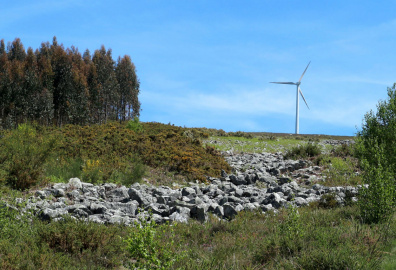
16.2.a San Fiz
GEOMORPHOLOGY OF THE MIÑO
The river Miño sources at an altitude of 700 metres in the Pedregal de Irimia, a glacial moraine under which we can hear the water flowing, although it will not come to the surface until six kilometres further downstream, in the Fonmiñá Lagoon. In this lagoon we can observe some curious bubbles, which are nothing more than CO2 resulting from the process of dissolution of the calcareous rocks of the "Caliza de Vegadeo" due to the spring of water.
After a journey of 316 kilometres through the provinces of Lugo, Ourense and Pontevedra, and making a natural border with Portugal in its last 76 kilometres, the river Miño flows into the Atlantic Ocean, between A Guarda and Caminha.
In the stretch that includes us, between Chantada and Os Peares, the river crosses the Ollo de Sapo anticlinorium and passes into the so-called Central-Iberian Zone, deeply fitting into the Chantada Surface, avoiding the Monforte Trench and creating meanders of great beauty such as Cabo do Mundo.
In Os Peares, the confinements of the Miño and the Sil disappear abruptly and both rivers converge, together with the Búbal, considerably increasing their flow and following their course through granite substrate towards the city of Ourense.
VITICULTURE AND AGRICULTURAL DEVELOPMENT
The agricultural use of steep slopes, such as the banks of the Miño, involves a tremendous work of building walls to settle the land and allow the cultivation work. They are therefore small farms, dedicated to the family and subsistence economy and closely linked to the villages.
The most particular case is viticulture, where the vines are arranged on terraces (here called socalcos, pataos, muras, bancadas...) perfectly adapted to the conditions of the land, with varying widths according to the possibilities and walls of different types and materials, which, as well as providing a cultivation area, serve to conserve the heat of the day, which favours the production of the plant.
This system of cultivation means that the work in the vineyards is very hard, and mostly manual, as there is no possibility of access with machinery, although nowadays there are some mechanical aids such as the transport rails that can be seen in various places. This is why it is called Heroic Viticulture.
The vineyards on these banks belong both to small vine-growers who make wine for their own consumption and to various wineries under the Ribeira Sacra Designation of Origin, created in 1996 to highlight the quality of the wines of this area.
 Directions
Directions 